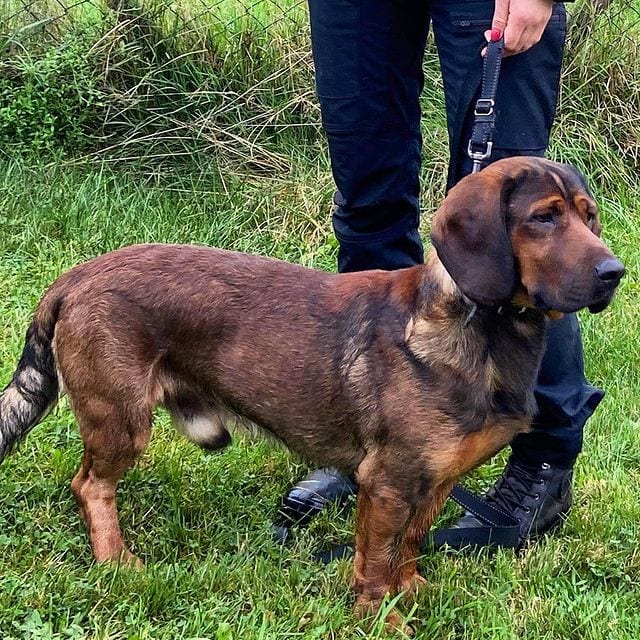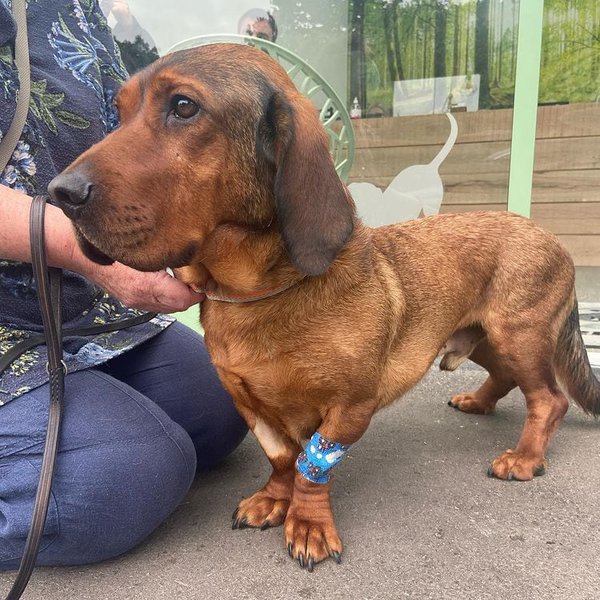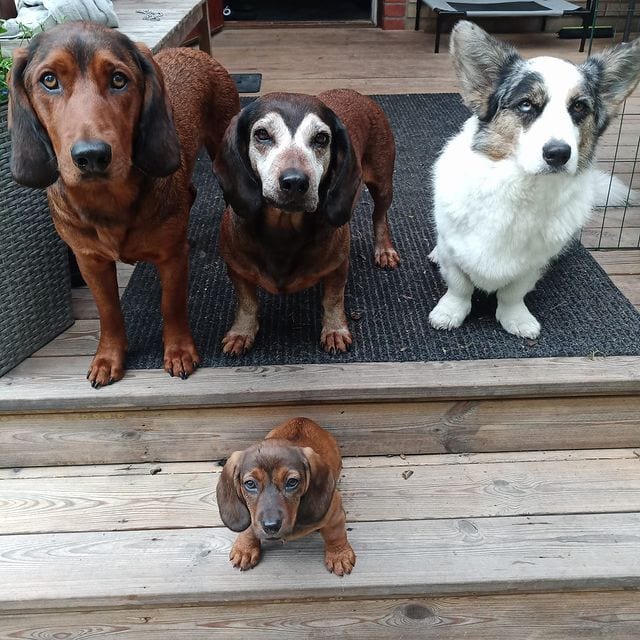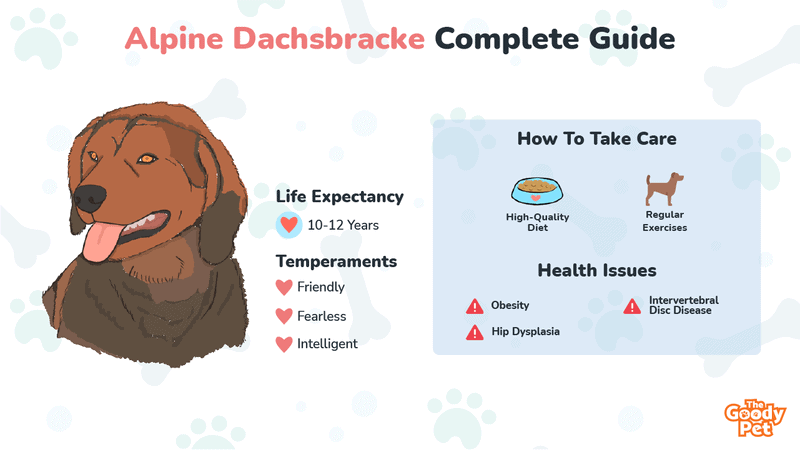No one can blame you if you think the Alpine Dachsbracke is a Dachshund at first sight. The similarities are striking. The Alpine Dachsbracke is considered to be one of the rarest dog breeds around. So rare that it gets a nod only from the United Kennel Club (UKC), and American Rare Breeds Association (ARBA).
Also called the Alpenländische Dachsbracke in German, the Alpine Dachsbracke originates from Austria and remains popular in that region. Its primary job was tracking wounded animals during a hunt. Having a keen sense of smell, your four-legged furry friend earns a place among the scent hounds.
The Alpine Dachsbracke’s lively personality makes it a great family dog. Your kids would love it too. But before keeping one of these as a pet, you must know how to get the best out of them. Here, you’ll find everything there is to know to make you a proud owner of this unique breed.
How Big Do Alpine Dachsbrackes Get?

The Alpine Dachsbracke is in the small breed category, with height varying between 13 to 15 inches. A full-grown one weighs between 33 to 40 lbs.
Here is an overview of the Alpine Dachsbracke’s physical appearance.
Face
Your furry canine features dark brown iris, a black nose, and a strong muzzle. Lips have a moderate curve and moderate fold at the edge. Ears are floppy by default.
Trunk
The Alpine Dachsbracke has a sturdy build and a strong-boned physique. You will find this dog to be quite muscular as well.
This furry canine also features an elongated trunk with a straight back. At the chest, it is deep and about half the extent approaching the shoulder. The fore chest is very noticeable.
Also, the Alpenländische Dachsbracke has a brushy tail that hangs a bit above the ground.
Limbs
Legs are generally short when compared to the body. Nevertheless, they have firm muscles. The hind limbs appear straight when viewed from the rear. Despite the short legs, the Alpine Dachsbracke is very agile and covers much space with quick trots.
Coat Type And Tone
Expect the coat of your Alpine Dachsbracke to be dense and double coated. Besides, the fur is short and level except for the tail and neck.
The most preferred color for this breed is dark deer red, possibly with spewed dark hairs. Black with some definite rust-red marking on body parts such as the head, legs, feet, and tail are also permissible. A white star on the chest has a general acceptance as well.
How Long Do Alpine Dachsbrackes Live?

According to publicly available data, Alpine Dachsbrackes are found to have a life expectancy of 10 to 12 years.
The longevity of this breed is short compared to other small dogs that can live between 12 to 20 years. Although this breed is generally healthy, they have their health challenges. Here are the notable ones.
Obesity
The Alpine Dachsbrackes risks getting overweight without adequate supervision of its diet. If that happens, it could lead to other forms of health problems for the dog.
You must see to it that it exercises regularly to burn out the fat. Besides, pay attention to the food type, quantity, and frequency of feeding to avoid getting an overweight dog.
Intervertebral Disc Disease (IVDD)
Like the Daschund, Alpine Dachsbrackes have a long trunk, making them vulnerable to this disease. It is a condition where the disk of the vertebra slips out of place or ruptures.
Depending on which area of the spine is affected, some symptoms include arching back, difficulty standing, unsteady movement, and shivering.
The best way to prevent this is by ensuring your furry canine friend doesn’t become overweight.
Hip Dysplasia
Also known as dislocation of the hips, it may be hereditary or self-caused. One condition that puts the Alpine Dachsbracke at risk of this disease is obesity. Too much weight on the hips could cause dislocation, considering that the structure isn’t advantageous for much weight.
Surgery is often needed to correct this health issue. Ensuring this dog breed exercises sufficiently and diets appropriately is crucial.
How To Take Care Of Your Alpine Dachsbracke?
Alpine Dachsbrackes are a strong breed but delicate. If they would live at optimum, several areas require our attention.
Plan For Their Exercise
These dogs were bred for the hunt and can track down animals no matter how long it takes. That tells you of the sort of energy they possess. Helping them to express themselves is crucial to keeping them healthy. They must have a daily exercise for not less than forty-five minutes.
Activities such as fetch, hide-and-seek, chasing the prey, and long strolls, would help them utilize their instincts and keep them exercised.
Watch Their Diet
Recall that Alpine Dachsbrackes are prone to obesity. For safety, veterinarian-recommended meals are best for your Alpine Drachsbracke. Pet Plate is perfect in this case, as meals contain natural and human-grade ingredients only.
Be flexible with the food quantity. The feeding charts on the label of the feed will guide you in deciding. The chart usually considers your pet’s weight range to fix the quantity. An activity-prone dog, like the Alpine Dachsbracke, should be getting 20% to 40% more than the label states.
They Need Vitamins
A balanced diet and exercise are great, but your Alpine Dachsbracke will also require some multivitamins. These would generally give their immunity a boost and keep them in top gear always. Again, the effect would be evident in their skin and coat. Supplements, such as fish oil and amino acids, help prevent skin infections that could arise.
Maintain Oral Health
Oral hygiene is invaluable to your dog’s health. Dental water additives come in handy to help you to keep your dog’s mouth fresh and healthy.
Temperaments Of Alpine Dachsbrackes
Alpenländische Dachsbrackes are generally found to be intelligent, friendly, and fearless.
There are yet more traits to learn about this dog breed. Below are some of their characteristics owing to their temperament.
Alertness
This dog breed shows an impressive level of determination in just about anything they do. That is typical of scent dogs. The usual way of expression is barking to alert its handler to a discovery.
Their level of loyalty to their owner is unwavering. You can trust them to keep your territory safe within the limit of their ability. Hence, this breed makes an excellent watchdog.
Socialization
Among other dogs, it is non-aggressive and relates well. That means there is nothing to worry about if you already have some dogs. However, other forms of pets may be in danger due to their natural high prey drive.
The Alpine Dachsbrackes is safe with children and gets along with them. A note of caution is that the kids handle them with care due to the delicate nature of their trunks.

Independence
As long as there is sufficient space to play around, the Alpine Drachsbracke does not require frequent attention. Unlike many small dogs, they do not risk having separation anxiety. That does not imply leaving them alone unattended for a long time.
You should check on them from time to time as they could pick up a scent and choose to go after it. Ensure fences have slow guards to prevent them from going out of the yard should such a thing occur.
Grooming Tips For Alpine Dachsbrackes
The Alpine Dachsbracke is a low-shedding dog, making it hypoallergenic.
However, all dogs require some grooming to keep their coats glowing and smell-free. Here is what to do in the case of the Alpine Dachsbracke.
Brush The Coat
Though this hunting dog is low shedding, you’ll need to brush its furs at least once a week. That would help you get off the loose hair and prevent the undercoat from knotting. You’ll need a brush specially built for a dog’s coat. We recommend the FURminator Undercoat Tool for this task.
While doing this, you’ll be able to spot any tick that may have clung to your furry companion.
Occasional Bathing
Although this dog breed won’t love it, you must bathe it once in a while. Bath your Alpine Dachsbracke only when you notice that it is dirty or scratching frequently.
We advise that you use dog shampoo only and not a variant. Pro Pet Works All Natural 5 In 1 Oatmeal Shampoo would be perfect for this. Its unique formulation restores the shine of your canine buddy’s coat. Allowing the dog’s hair to dry naturally is best to prevent heating from dryers or possible itching from towels.
Ear Care
Dogs with floppy ears risk getting ear infections owing to possible moisture secretion and poor air circulation. Therefore, it becomes pertinent to clean the underneath of the Alpine Dachsbracke’s ears routinely.
Make use of clean clothing with the fluid made for that purpose. Meanwhile, check the ears for mites because they could be lodging there.
Related Questions
Do Alpine Dachsbrackes Swim? Yes, Alpine Dachsbracke can swim, but with much difficulty. The short legs coupled with an elongated body structure of this hunting dog is a natural disadvantage. Hence, be sure you’ve trained it enough to do so with a floater before attempting a pool. When it eventually does, keep the duration short.
How Much Does An Alpine Dachsbracke Cost? An Alpine Dachsbracke puppy will cost between $700 to $1,500. This breed is rare and not commonly found in the US. There are only a few breeders around, so you may have to import yours. If you’re buying from sellers that render after-sales services, the price may be much higher.
What Are The Differences Between Alpine Dachsbrackes And Westphalian Dachsbrackes? Alpine Dachsbrackes And Westphalian Dachsbrackes, among other areas, differ in origin and coat color. While the former originates from Austria, the latter has its source from Germany. Also, Alpine Dachsbrackes favor a coat of dark deer red with some black. Meanwhile, Westphalian Dachsbrackes are tricolored with white markings on red to yellow patterns with a black saddle.





